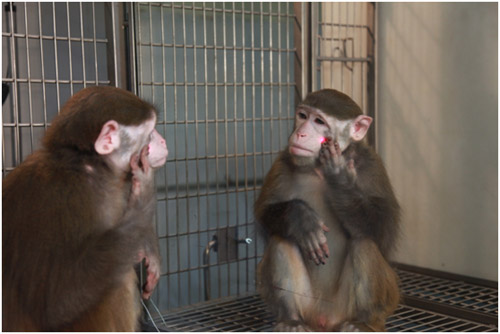Time:2015-01-09
Unlike humans and great apes, when rhesus monkeys look in the mirror, they do not realize that it is their own face looking back at them. However, according to a recent study, they can learn to do so following training. What’s more, once rhesus monkeys in the study developed mirror self-recognition, they continued to use mirrors spontaneously to explore parts of their bodies they normally cannot see.
In earlier studies, scientists had offered monkeys mirrors of different sizes and shapes for years, even beginning at a young age. While the monkeys could learn to use the mirrors as tools for observing other objects, they never showed any signs of self-recognition. When researchers marked the monkeys’ faces and presented them with mirrors, they didn’t touch or examine the spot or show any other self-directed behaviors in front of those mirrors.
In a recent study, CHANG Liangtang and colleagues, under the supervision of Dr. GONG Neng at the Institute of Neuroscience, Shanghai Institutes for Biological Sciences, Chinese Academy of Sciences tried something else. They sat the monkeys in monkey chairs in front of a mirror and shined a mildly irritating laser light on their faces. After two to five weeks of training, these monkeys had learned to touch face areas marked by a non-irritant spot in front of a mirror. They also noticed virtual face marks in mirroring video-images on a screen. Furthermore, they have learned to pass the standard mark test for mirror self-recognition.
Most of the trained monkeys, five out of seven, showed typical mirror-induced self-directed behaviors, such as touching the mark on the face or ear and then looking and/or smelling their fingers as if they were thinking “hey, what’s that there on my face?” They also used the mirrors in other ways that were unprompted by the researchers, to inspect other body parts that normally they cannot see.
These findings suggest that the monkey brain has the basic "hardware" for mirror self-recognition, but need appropriate training to acquire the "software" to achieve self-recognition.
This discovery in monkeys sheds light on the neural basis of self-awareness in humans and other animals, and comes as hopeful news for people who are unable to recognize themselves in the mirror due to brain disorders such as mental retardation, autism, schizophrenia, or Alzheimer’s disease.
This research entitled "Mirror-Induced Self-Directed Behaviors in Rhesus Monkeys after Visual-Somatosensory Training" was published online in the Cell Press journal Current Biology on January 8th. The work was supported by the MoST 973 Program of China (2011CBA00400), Strategic Priority Research Program of the CAS (XDB02020100), and CAS Youth Innovation Promotion Association and a SA-SIBS scholarship to GONG Neng.

 附件下载:
附件下载: